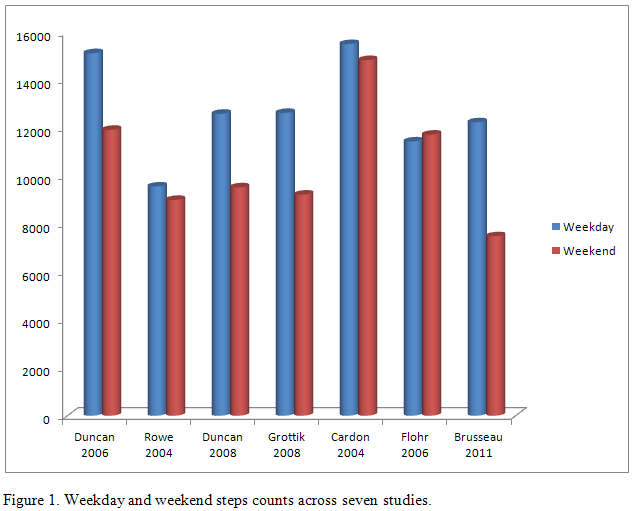A REVIEW OF THE DAILY STEP COUNTS OF CHILDREN ON WEEKDAYS AND WEEKENDS
written by Timothy
A Brusseau, The College at Brockport (biography)
 Since
the publication of the Rowlands, Eston, and Ingledew (1997)
study, the pedometer has become an acceptable means of measuring
physical activity (PA) levels that has repeatedly shown that
it can produce reliable and valid scores, even with children
(Trost, Pate, Freedson, Sallis, & Taylor, 2000). Over
the last decade the pedometer has become a popular tool for
measuring PA. Since
the publication of the Rowlands, Eston, and Ingledew (1997)
study, the pedometer has become an acceptable means of measuring
physical activity (PA) levels that has repeatedly shown that
it can produce reliable and valid scores, even with children
(Trost, Pate, Freedson, Sallis, & Taylor, 2000). Over
the last decade the pedometer has become a popular tool for
measuring PA.
As a result of its low cost and ease of use, pedometers are
used frequently to assess children's PA in field settings
(i.e. Brusseau, Kulinna, Tudor-Locke, Ferry, van der Mars,
& Darst, 2011; Vincent & Pangrazi, 2002). Research
studies continue to accumulate demonstrating the utility of
the pedometer to objectively measure childrens' activity patterns.
Multiple recent reviews of pedometer-determined PA studies
(Beets, Bornstein, Beighle, Cardinal, & Morgan, 2010;
Tudor-Locke, McClain, Hart, Sisson, & Washington, 2008)
have found well over 50 studies that have determined free-living
activity patterns of children. Very few of these studies have
explored differences between weekday and weekend step values.
Those that have suggest varied and conflicting findings.
Seven studies have examined pedometer-determined PA of youth
during weekdays compared to weekend days. Figure 1 illustrates
differences between weekdays and weekend days across studies.
The studies examined students ranging in age from 6 to 18,
and ranged in number of participants from 44 to over 1,500.
Duncan and colleagues (2006) examined the physical activity
of 1,115 (ages 5-13) children from New Zealand. Children were
monitored for two weekend days and three weekdays. During
the weekdays, boys accumulated an average of 16,132 steps/day
and girls averaged 14,124 steps/day. This was significantly
different from the weekend days, where boys accumulated an
average of 12,702 steps and girls accumulated an average of
11,158 steps.
Rowe, Mahar, Raedke, and Lohr (2004) also reported significant
differences in a study of 210 children between the ages of
10-14 years. They found that these children (did not report
by sex) accumulated an average of 9,504 steps/day during the
weekdays and 9,005 steps/day during the weekend. More recently,
Duncan, Duncan, and Schofield (2008) examined the physical
activity patterns of over 1,500 female New Zealand children
and youth. This study found that girls averaged 12,597 steps
per weekday and 9,528 steps per weekend day. They found that
children of European descent were the most active on weekends,
as compared to weekdays, and that both weekday and weekend
steps/day generally decreased as the children advanced in
age.
This study also explored the effects of socioeconomic status
on the PA patterns of this population. The results suggest
that girls from a low socioeconomic (SES) home averaged 8,724
steps per weekend days compared to 10,410 and 9,871 steps
per weekend day for middle and high SES students, respectively.
Cardon and Bourdeaudhuij (2004) did not analyze the PA data
by sex, but found that 92 children (ages 6-12) accumulated
an average of 15,508 steps during weekdays, and 14,840 during
the weekend days over six consecutive days in Flanders, Belgium.
Flohr, Todd, and Tudor-Locke (2006) did not find a significant
difference between weekday and weekend day PA in 44 twelve
year old youth. Boys accumulated an average of 11,980 steps
on Physical Education days and 13,159 steps on health days,
and girls accumulated an average of 9,978 steps on health
days and 10,660 on Physical Education days.
The differences between health and Physical Education days
may be attributed to varying participation in after-school
activities. This is compared to an average of 13,000 steps
for boys and 10,455 steps for girls during the weekend days.
The girls in this study were the lone sub-sample to be more
active on the weekend days; however, there was not a reason
suggested for this result.
Brusseau, Kulinna, Tudor-Locke, van der Mars, & Darst,
(In press) compared the weekday and weekend steps counts of
three hundred and sixty-three children (8-11 years old) from
six Southwestern USA elementary schools. Results indicated
that during weekdays, the fourth and fifth grade children
averaged 13,196 ± 3,334 and 11,295 ± 3,168 steps/day
for boys and girls, respectively. This is compared to a weekend
average of 7,660 ± 4,647 steps/day (boys) and 7,317
± 4,062 steps/day (girls).
This study also examined steps/day on Physical Education
and non Physical Education Days. Children were significantly
more active on physical education days, averaging 12,979 steps/day
(14,197 ± 4,697 steps/day for boys and 12,058 ±
3,772 steps/day for girls), compared to non-physical education
school days, when they accumulated 11,809 steps/day (12,788
± 3,600 steps/day for boys and 11,047 ± 3,382
steps/day for girls). They also suggested that children having
Physical Education 2 or more days per week averaged greater
steps/day than students with only 1 Physical Education day/week.
In a study examining the weekday and weekend steps of Polish
adolescents (average age of 17.9 years; Groffik, Fromel, &
Pelclova, 2008) the youth averaged between 12,138-12,609 (boys)
and 12,523-13,267 (girls) on weekdays. On weekends these youth
averaged 8,381-8,928 and 9,311-10,283 for boys and girls,
respectively. This group of young people averaged approximately
3,200-4,300 and 3000-3,200 steps/day less on weekend days
for boys and girls, respectively.
Based on these findings, children and youth are generally
more active on week days than weekend days. This supports
previous literature suggesting that children are less active
on weekend days compared to week days (e. g. Gavarry, Giacomoni,
Bernard, Seymat, & Falgairette, 2003). Further, few children
and youth appear to be meeting the daily recommended steps/day
(13,000 and 11,000 for boys and girls, respectively) on weekend
days set forth by the President's Challenge Physical Activity
and Fitness Awards Program (President’s Council on Physical
Fitness and Sports, 2001). It would also appear that most
children and youth need increased physical activity programming
and interventions on weekend days.

Dr. Tim Brusseau is an Assistant Professor in the Department
of Kinesiology, Sport Studies, & Physical Education at
the College at Brockport, State University of New York. Dr.
Brusseau's teaching specialty is secondary physical education
and coaching. His research interests are related to understanding
children and youth physical activity and interventions targeting
their physical activity.
(back
to pelinks4u homepage) |




 Since
the publication of the Rowlands, Eston, and Ingledew (1997)
study, the pedometer has become an acceptable means of measuring
physical activity (PA) levels that has repeatedly shown that
it can produce reliable and valid scores, even with children
(Trost, Pate, Freedson, Sallis, & Taylor, 2000). Over
the last decade the pedometer has become a popular tool for
measuring PA.
Since
the publication of the Rowlands, Eston, and Ingledew (1997)
study, the pedometer has become an acceptable means of measuring
physical activity (PA) levels that has repeatedly shown that
it can produce reliable and valid scores, even with children
(Trost, Pate, Freedson, Sallis, & Taylor, 2000). Over
the last decade the pedometer has become a popular tool for
measuring PA. 